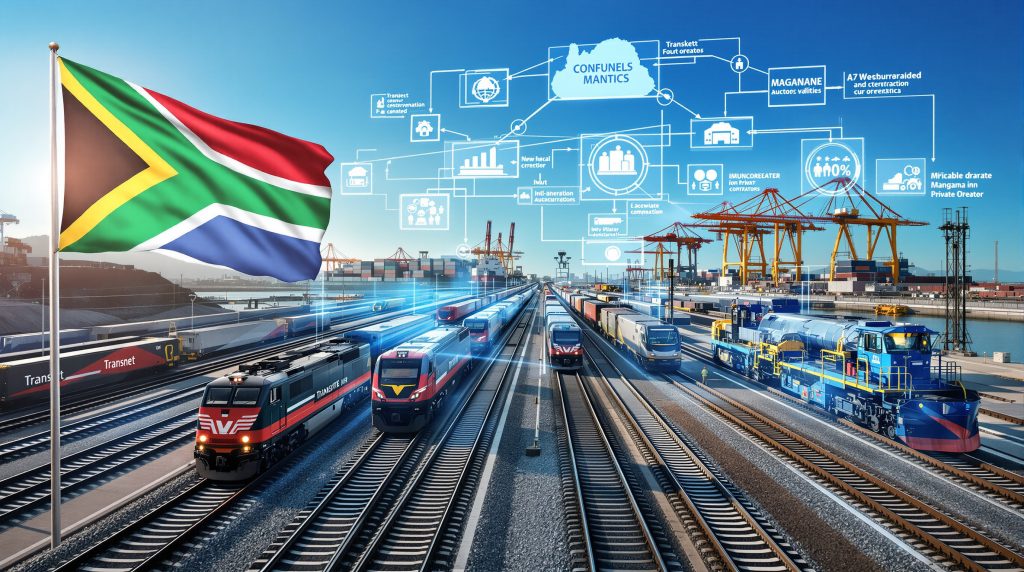The Critical Role of Logistics in Mining Productivity
South Africa's mining sector stands as a cornerstone of the national economy, contributing significantly to GDP, employment, and export earnings. However, the sector's true potential has been constrained by persistent logistics bottlenecks that hamper the efficient movement of minerals from mines to markets. These constraints have historically limited production capacity, increased operational costs, and reduced global competitiveness.
Land logistics costs represent approximately 35% of total production costs for operations like the Tshipi manganese mine, compared to just 10-15% for the modern mine planning operations themselves. This striking cost imbalance underscores why logistics performance has become a critical focus for the industry's future growth.
Why Logistics Matter for Mining Success
The economics of mining in South Africa are heavily influenced by transportation costs, with logistics representing between 15-35% of total operational expenses depending on the commodity and location. For bulk minerals like iron ore, coal, and manganese, efficient rail and port infrastructure is particularly critical to maintaining viable operations.
Mining executives consistently emphasize that rail haulage operations represent the most significant operational constraint for bulk mineral exporters in South Africa, affecting both production planning and market access.
The Historical Logistics Challenge
For decades, South Africa's mining sector has faced significant challenges with:
- Rail capacity constraints limiting export volumes
- Port congestion causing shipping delays
- Aging infrastructure requiring maintenance and upgrades
- Operational inefficiencies increasing costs
- Limited private sector participation in logistics solutions
These constraints have been especially pronounced in the manganese sector, where production has outpaced logistics capacity. As industry leaders note, the issue isn't necessarily performance-based but rather stems from capacity limitations that haven't kept pace with export growth over the past 15 years.
Current State of Logistics Reforms
South Africa's logistics reform process is gaining momentum, with private sector participation and government-business collaboration showing measurable progress. Industry leaders describe the engagement with state logistics provider Transnet as "very positive" over the past 18-24 months, signaling a meaningful shift in collaborative problem-solving.
Public-Private Partnerships Gaining Momentum
Recent reforms have opened South Africa's rail network to private operators for the first time in the country's history. This watershed development has seen 11 private train operators approved to run services on 41 routes, covering all major mining corridors in the country.
This structural change directly addresses the monopolistic constraints that previously limited innovation and capacity expansion in the rail sector, introducing much-needed competition and investment.
Targeted Rail Capacity Expansion
The private sector participation model is projected to add 20 million tons of rail capacity over the next five years. This represents the first phase of a broader strategy aimed at increasing total freight movement to 250 million tons by 2030—a target that aligns with Transnet's long-term vision.
Mining executives characterize this initial capacity expansion as "just the first window," with expectations of subsequent phases to fully realize South Africa's mineral export potential.
Collaborative Approach Between Government and Industry
The reform process has been characterized by increasing collaboration between mining companies, logistics providers, and government entities. The Minerals Council South Africa has played a pivotal role in facilitating dialogue and coordinating industry-wide responses to logistics challenges.
This collaborative approach combines individual company initiatives with collective industry efforts to expand logistics capacity, creating multiple pathways to overcome historical constraints.
What Are the Key Reform Initiatives?
Rail Network Access for Private Operators
The most significant reform has been opening the rail network to third-party operators. This marks a historic shift in South Africa's logistics landscape, with 11 train operating companies now approved to run services across 41 routes covering all major mining corridors.
Benefits of Rail Network Access:
- Increased competition driving service improvements
- Additional investment in rolling stock
- Specialized operators focusing on specific commodities
- Greater flexibility in scheduling and routing
- Reduced dependency on a single service provider
The introduction of multiple operators introduces market forces that encourage innovation, efficiency, and customer-focused service delivery across the logistics value chain.
Port Modernization Programs
Complementing rail reforms, South Africa is implementing comprehensive port modernization initiatives to enhance export capacity and efficiency.
Port Reform Elements:
- Terminal upgrades at Richards Bay and other key mineral export facilities
- Modernized loading equipment to increase throughput
- Improved berth allocation systems
- Enhanced port-rail interface coordination
- Digital tracking systems for cargo management
These port improvements are essential to preventing bottlenecks simply shifting from rail to harbor facilities as inland transport capacity increases.
Alternative Export Routes Development
Mining companies are proactively developing alternative export routes to mitigate risks associated with primary corridors.
Examples of Alternative Routes:
- Road transport to secondary ports like East London
- Cross-border solutions utilizing Namibia's Port of Lüderitz
- Multi-modal transport combinations to optimize flexibility
- Strategic stockpile management at multiple locations
This diversification strategy creates greater system resilience and provides contingency options when primary routes face constraints or disruptions.
How Are Mining Companies Responding?
Case Study: Manganese Exporters' Adaptation
Manganese producers exemplify the industry's response to logistics constraints. With rail capacity only able to accommodate approximately 50% of production volumes, companies have implemented innovative solutions:
- Developing road transport alternatives despite higher costs
- Exploring export options through neighboring countries like Namibia
- Investing in private sidings to improve rail interface efficiency
- Forming collaborative logistics partnerships with other producers
The Tshipi manganese mine, which produces 3.6 million tonnes annually but can only transport about half through rail infrastructure, illustrates these adaptation strategies. Their approach focuses on continuous improvement and lowering operating risks and costs while maintaining rail as the primary priority.
Investment in Private Infrastructure
Mining companies are making substantial investments in privately-owned logistics infrastructure to complement public systems:
- Private rail sidings and loading facilities
- Storage and handling facilities at ports
- Road transport fleets and maintenance facilities
- Digital logistics management systems
These investments allow data‑driven operations to maximize efficiency within their direct control while supporting the broader logistics ecosystem improvements.
Supply Chain Resilience Strategies
The post-COVID environment has accelerated the adoption of supply chain resilience strategies, including:
- Diversification of logistics partners and routes
- Implementation of advanced technologies (AI, blockchain, IoT)
- Increased inventory buffers at strategic locations
- Enhanced visibility through integrated tracking systems
Mining companies now approach logistics with greater emphasis on flexibility and redundancy, recognizing that over-reliance on single transport options increases operational risk.
What Results Are Being Achieved?
Measurable Progress in Rail Performance
While reforms are still in early stages, tangible improvements are already being observed:
- Increased volumes on key mining corridors
- Improved schedule reliability for participating operators
- Reduced dwell times at interchange points
- Greater predictability for production planning
Industry executives express optimism that these early gains will accelerate as private operators fully establish their services and infrastructure investments mature.
Economic Impact of Logistics Improvements
The economic benefits of logistics reforms extend beyond the mining sector:
- Enhanced export earnings from increased mineral shipments
- Job creation in logistics services and supporting industries
- Improved investor confidence in mining projects
- Reduced costs for domestic mineral consumers
The multiplier effect of efficient logistics creates value throughout the economy, from mining communities to port cities and manufacturing centers.
Competitiveness Gains for South African Mining
Logistics reforms are enhancing South Africa's global competitiveness in key mineral markets:
- More reliable supply to international customers
- Reduced total delivered costs for certain commodities
- Enhanced ability to respond to market opportunities
- Improved sustainability credentials through more efficient transport
Industry leaders note that these improvements will help South African beneficiation and globally leading mineral franchises, particularly in manganese, "realize their full potential" in international markets.
What Challenges Remain in the Reform Process?
Implementation Timelines and Capacity Building
Despite positive momentum, several challenges remain in the reform implementation process:
- Developing technical capacity for new private operators
- Establishing clear regulatory frameworks for multi-operator environments
- Managing the transition period while maintaining existing services
- Coordinating investments across multiple stakeholders
The pace of reform implementation has been slower than some industry participants would prefer, requiring patience and sustained commitment through the transition period.
Funding Requirements for Infrastructure Development
The scale of infrastructure investment required presents significant funding challenges:
- Estimated R200 billion needed for comprehensive logistics infrastructure upgrades
- Competition for capital with other national priorities
- Need for innovative financing structures
- Balancing user fees with competitiveness requirements
Securing adequate and sustainable funding remains a critical factor in achieving long-term logistics capacity targets.
Operational Integration Complexities
The shift to a multi-operator environment introduces operational complexities:
- Traffic management across shared infrastructure
- Standardization of equipment and systems
- Coordination of maintenance schedules
- Emergency response protocols
Developing effective systems for managing these complexities will be essential to realizing the full benefits of a more diverse logistics ecosystem.
Future Outlook for Mining Logistics
Technology Integration Opportunities
The future of mining logistics in South Africa will be increasingly shaped by technology:
- Automated train operations improving capacity utilization
- Predictive maintenance reducing infrastructure downtime
- Digital twins enabling better system optimization
- Blockchain solutions enhancing cargo tracking and documentation
These technologies offer potential to extract greater efficiency from existing infrastructure while supporting more responsive and adaptive logistics systems.
Potential for Regional Logistics Integration
South Africa's logistics reforms have potential implications for regional mineral transport:
- Enhanced corridors serving neighboring countries' mining sectors
- Coordinated infrastructure development across borders
- Standardized regulations facilitating cross-border movements
- Shared investment in strategic regional assets
The benefits of improved logistics systems could extend throughout Southern Africa, creating more integrated and efficient regional mineral value chains.
Environmental Sustainability Considerations
Future logistics development will increasingly incorporate sustainability considerations:
- Electrification of rail operations reducing carbon footprint
- Optimized routing and scheduling minimizing fuel consumption
- Modal shift from road to rail reducing overall emissions
- Water management improvements at port facilities
As environmental standards and carbon pricing mechanisms evolve, the sustainability advantages of efficient logistics will become increasingly important competitive factors.
How Can Mining Companies Maximize Benefits?
Strategic Planning Recommendations
To maximize benefits from logistics reforms, mining companies should consider:
- Aligning production expansion with confirmed logistics capacity
- Participating in collaborative industry initiatives
- Developing contingency plans for remaining bottlenecks
- Investing in supporting infrastructure at mine sites
Forward-looking production planning that accounts for realistic logistics capacity development will help companies avoid costly misalignments between mining output and transport capabilities.
Stakeholder Engagement Strategies
Effective stakeholder engagement remains critical to reform success:
- Maintaining constructive dialogue with government entities
- Collaborating with communities along transport corridors
- Engaging with other industrial users of shared infrastructure
- Participating in industry associations focused on logistics issues
The collaborative approach that has characterized recent progress must continue to ensure reforms remain aligned with industry needs and priorities.
Skills Development Focus
The changing logistics landscape creates new skills requirements:
- Training programs for technical specialists
- Development of logistics management expertise
- Digital literacy for technology-enabled operations
- Regulatory compliance capabilities
Companies and industry associations will need to invest in developing the human capital required to fully leverage improved logistics systems, as highlighted in recent mining conference insights.
Conclusion: The Path Forward
South Africa's mining logistics reforms represent a critical turning point for the sector's global competitiveness. While progress has been made, sustained commitment from all stakeholders will be required to fully realize the potential benefits.
The transformation of mining logistics from a constraint to an enabler of growth will depend on continued policy reform, infrastructure investment, operational excellence, and technological innovation. With these elements in place, South Africa's mining sector can overcome historical bottlenecks and establish a more sustainable foundation for future prosperity.
The collaborative approach between government and industry that has characterized recent reforms provides a template for addressing other challenges facing the sector. By maintaining this spirit of partnership, South Africa can accelerate the pace of logistics reforms and unlock the full potential of its mineral resources.
Disclaimer: This article contains forecasts and speculation regarding future developments in South Africa's logistics sector. These projections are based on current trends and announced plans but are subject to change due to policy shifts, funding availability, and other external factors.
Ready to Capitalise on the Next Major Mineral Discovery?
Don't miss out on significant ASX mineral discoveries that could transform your investment portfolio. Visit Discovery Alert's dedicated discoveries page to see how their proprietary Discovery IQ model turns complex mineral data into actionable insights, helping you position yourself ahead of the market.




